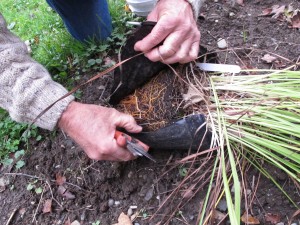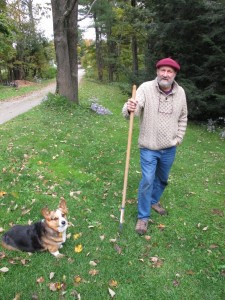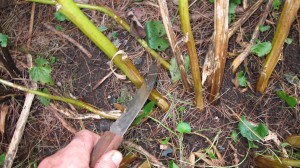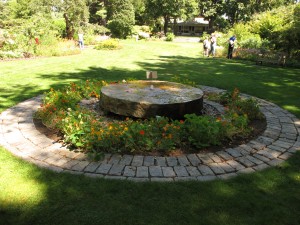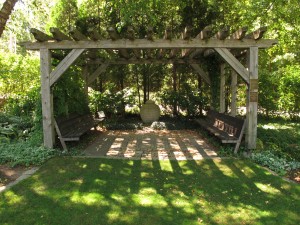Gardening with Aches and Pains
As we get older, most of us develop aches and pains. As gardeners, we need to learn how to move and use our bodies so that we don’t end up feeling like a quarterback after a sacking. I love working as a garden coach, partly because I am, at heart, a school teacher; I also like finding solutions to almost anything. One of my clients, a woman with a bad shoulder, got me thinking about all the tricks I have learned over the years to minimize pain caused by gardening.
My client and I were planting some pretty big hostas. They were in large plastic pots and probably weighed about 15 pounds each. I showed her how to hold the pot upside down in one hand, and smack the bottom of the pot with the other so that the roots and soil would slide out of the pot. But with her bad shoulder, she couldn’t do that.
I taught her to cut open the pot instead. It’s a technique I use when working with trees in pots. I placed the pot on the ground and inserted the blade of my ever-present pruners into one of the drain holes at the bottom of the black plastic pot. I slit up the side to the top, and then sliced again across the bottom. Then I rolled the rootball free of the pot. Finally, I tickled the roots to loosen them up – so they will be ready to explore their new environment.
Getting down on your knees to plant anything (or to pull weeds) is tough if you have arthritic knees or hips. I can recommend a couple of ways to deal with it. My late friend Marguerite Tewksbury, a lifelong organic gardener who lived in Windsor, VT, started carrying a hoe in the garden in her late eighties. She used it not only like a walking stick, it helped her getting down – or up. By leaning on a hoe, you can distribute your weight and make a more stable, 3-point stance.
Of course I am young and healthy at 67, so I don’t need any aids getting down to weed. But sometimes at the end of the day, it’s nice to have something to lean on when on getting up. I like a 5-gallon pail for that, I can push up on it and get up more easily, with less strain on my back. Or sometimes I use my CobraHead weeder to help push me up a little.
Picking beans recently I found bending over tiresome for the length of time I needed to pick all my beans. So I used a 5-gallon pail to sit on. Gardener’s Supply (www.gardeners.com) makes something that looks very good, their “garden kneeler”; it has hand rails at the sides for getting up when kneeling or that allow you to convert it into a seat.
If you suffer from carpal tunnel, pruning may be painful for you. Most manufacturers now make hand pruners with a rotating grip that allegedly minimizes the problem. The Fiskars company has come out with a series of pruners and lopers that offer a different technology – gears to reduce the amount of pressure it takes to make a cut. I have a pair of their biggest loppers, and find them fabulous. The gears really do reduce the work of cutting larger diameter hardwood branches.
One of the most ingenious tools I ever saw used was a homemade corn planter used – and made – by a man in his 90’s. I saw him using it as I drove down the road, and I stopped to talk. He could no longer bend down to plant the seeds, so after his garden was rototilled by his son-in-law, he used a hoe to make a furrow for the seeds. Then he planted using a 30-inch piece of garden hose to get the seeds from his hand to the ground.
The hose poked up through a wide tin can (perhaps a fruit cake or cookie tin). He put all his corn seeds in the can, and then picked them up one at a time and dropped them into the hose (which poked a couple of inches into the can). Then he moved on a few inches and did it again. I’m sure that corn tasted mighty good to him, in part, because he had figured out how to keep on gardening.
Some of my friends who have moved to retirement communities keep their hand in gardening by planting in pots on a deck. Instead of 20 tomato plants, one or two in self-watering containers is what they manage. A pot roughly the size of a 5-gallon pail will do nicely for a tomato – and not have much room for weeds. Smaller pots sitting on railings can handle lettuce or basil very nicely.
If your back bothers you, be careful when hoeing or raking. Don’t lean forward. Keep your back straight. And if you need to pick up a bucket of weeds, place one foot forward and as you bend, tighten your tummy muscles.
None of us is getting any younger. But if you like gardening, you should be able to garden forever. I intend to. Please write or e-mail me if you have a good tip or trick. I’ll post them on my Web site, www.Gardening-Guy.com. Thanks.
Contact Henry at P.O. Box 364 Cornish Flat, NH 03746 or e-mailing him at henry.homeyer@comcast.net. He is the author of 4 gardening books and a recent children’s book about a boy and a cougar, Wobar and the Quest for the Magic Calumet.
Putting the Garden to Bed
When you think of the weeks ahead, do you think that putting the garden to bed means simply raking the leaves and cutting back a few perennial flowers? Or maybe just putting the lawnmower in the garage and the tomato plants on the compost pile? Then you are a minimalist. To have maximum success in the garden, there are many tasks to do between now and the time when snow flies.
If you moved your houseplants plants outside for the summer, begin bringing them in now. Many don’t tolerate even a taste of frost. Wash the leaves on both sides and rinse the surface of the potting mix it’s growing in, too. That will help to wash off aphids and aphid eggs. Inside there are no good bugs to keep the ever-present aphids under control.
If you have an amaryllis that you put outside (either in a pot or in the soil), and want to make it bloom again this winter, bring it inside now. Let it rest un-watered in a dark, dry place for 45 days, then re-pot it (if it was in the ground) and put it on a windowsill. If re-potting, use a fluffy potting mix with lots of peat moss. Garden soil will rot the bulb.
If you grew dahlias and gladiolas, the bulbs will need to be pulled and stored in a paper bag in a cool, dark place until spring. Wait until the tops die back after the first frost – but don’t wait until the ground is near freezing. In the bag with bulbs you can put some slightly damp cedar gerbil bedding. That will help to keep them from drying out over the winter.
Fall is the time to get ahead on next summer’s weeds in garden. Do this by getting rid of all weeds in the flower beds (hopefully before they drop seeds) and in the vegetable garden, which should be clean and weed-free before snow flies. As you harvest vegetables, also weed and clean up. Getting rid of the dead plants in the vegetable garden will minimize the overwintering of things like beetles and fungi.
Now is the time to improve your lawn. Got dead spots, worn out spots? Re-seed in the fall, earlier rather than later. You want to get the new grass plants well established before the soil gets too cold. Germination is quicker now than in the spring – August’s warmth is still held in the soil. Just be sure to keep the soil lightly moist. I usually cover grass seed with a light layer of mulch hay or straw to provide shade on the hot Indian summer days.
Fall is also a good time to give your lawn a dose of limestone and organic fertilizer. It will slowly be incorporated into the soil over the months ahead. You can have the lawn soil tested by your Cooperative Extension, or just Google “soil testing” and learn how to take a sample and where to send it. Most lawns will benefit from some compost. Just fling it with a shovel, and spread it around with the back side of a lawn rake (with the tines in the air).
At some point before winter, prepare your beds for planting next year’s vegetable garden. That will allow you to plant early crops like spinach and peas much earlier if we have, as we usually do, a wet spring. It’s never good to work in wet soil. And rototilling should be avoided until the soil dries out (though I personally don’t till anymore). Later, after I’ve raked up my leaves, I’ll spread them over my mounded, raised beds. Raised beds dry out and warm up faster than beds that are flat.
Flower beds get better each year. Or they do if you pay attention to your soil by adding organic matter. If you have mulch on your beds, rake it off and spread some compost or sheep manure over the surface. Then scratch it in a little and put back the mulch. Sheep, goat, llama and rabbit manure is all relatively free of weed seeds and adds organic matter and minerals to the soil. A top dressing of organic fertilizer will improve the soil, too. Unlike many chemical fertilizers, most components of organic fertilizer are not water soluble.
You can divide big clumps of purple cone flowers, black-eyed Susan, phlox, asters, hostas, iris, daylilies and most other perennials either now or in the spring. The more you do now, the less you will have to do in spring. Moving or dividing peonies is generally recommended for the fall, after the plants have begun to go dormant.
There’s plenty more to do before the snow flies, and I will nag you again later to do more including cleaning up your berry patch and cutting back this years’ fruiting canes, pruning hardwood trees and deciduous shrubs after leaf drop, planting bulbs and more. Meanwhile, enjoy the crisp days of fall and find time to watch the butterflies feeding on our last flowers of summer.
Henry Homeyer is the author of 4 gardening books and a Wobar, a fantasy-adventure book for children. His Web site is www.Gardening-guy.com.
Designing a Garden, and Expanding Your Plant Palette
Want to have a spectacular flower garden? Nothing beats visiting a good garden when it comes to learning how to make your own better. I recently visited Kirkwood Garden on Rte 3 in Holderness, NH. I had visited it last spring when I was invited to speak at the Squam Lakes Natural Science Center. I was bowled over by the plant diversity, the beauty of the layout, and the tranquility of the garden. But I didn’t have my camera and notebook, so I went back in August and was once again delighted – and instructed – by the garden.
It is easy to look at a professionally designed and maintained garden and say, “I could never do that.” And for many gardens that’s true. Longwood Gardens in Pennsylvania or the Brooklyn Botanical Gardens encompass dozens of acres and are maintained by teams of workers year round. But Kirkwood Garden is less than an acre (in my estimation) and I’m told it is maintained by a single gardener. And it has not been around for decades. It was installed in 1996 – largely by volunteers, and with many donated plants.
So what pleases me so much about this garden? First is the overall design and layout. If you walk down three broad stone steps, you are on a large central lawn – but one that is carved up and delineated by curved flower beds, islands and walkways that head off to shady nooks. No straight lines here. I like that. And there are places to sit, with nice 2-foot square flagstones laid out in front, so that dozens of daily feet will not create bare spots. And there are shady places as well as sunny places to sit.
Each bed is backed by shrubbery, with the tallest plants towards the back. When I visited in spring, the rhododendrons, azaleas and mountain laurels were in bloom. Many different varieties, each with a different color and slightly different bloom time. Now there is summersweet clethra (Clethra alternifolia) with its intense sweet blossoms, and a lovely viburnum (Viburnum sieboldii) loaded with red berries held upright on bright yellow stems.
Also in the back of the beds – and blooming now – are many tall perennials. I grow and love snakeroot (also called bugbane, but technically Cimicifuga racemosa). But instead of a couple of plants, someone has planted many, or allowed them to spread over the 17-year life of the garden. I tend to have many varieties of plants inter mingled. They have many large stands of a single species, which makes a bold design statement.
A tall fall plant I have only tried once, and not found to be worth keeping, is Boltonia (Boltonia asteroides). They selected a variety called ‘Snowbank’, which my reference text tells me is unlike most boltonias, in that it is self supporting. It is 3-5 feet tall at Kirkwood and stands up without support, while the generic boltonia I tried was 5-6 feet tall and flopped over. At Kirkwood it has formed a cluster about 8 feet wide and 5 feet across and each stem supports a very small white daisy-like blossom. I shall try again.
Speaking of flopping, some annuals (purple cone flower, for one) were supported by horizontal grids of wire. Green wire mesh with 2 inch openings was supported on bamboo stakes about 18 inches off the ground (parallel to the ground) allowing stems to grow through the wire,. The wire was unobtrusive and kept the tall flowers from flopping. Very clever – but will I remember to do that next spring? And will you?
An unusual fall bloomer at Kirkwood, which I have only rarely seen used, is yellow waxbells (Kirengeshoma palmata). This is a shade loving perennial with large maple-looking leaves and large yellow flowers. I have to admit it is slug bait, for me, but on a good year it can be a wonderful addition to a shady garden in the autumn. It is technically only hardy to Zone 5 (minus 20 in winter) but it has survived colder temperatures in my garden.
I learned there that the gorgeous bright red cardinal flower (Lobelia cardinalis) will survive in ordinary garden soil – not just in wet places (which is where it grows in the wild, and where I have it in my garden). Just plant in with some afternoon shade. I shall try that, too.
What else did I like about Kirkwood Gardens? It has maps everywhere, which although initially difficult to figure out, actually work quite well. You can learn the names of lots of different plants, annuals, perennials and woodies. And the garden is open year round and free to all. Donations are gratefully accepted. So you can visit often and see how special plants look in the different seasons.
Last of all, I agree with Barbara Gillan of Stillwater, N.J, who I met while admiring the garden. She and her family visit every year and remarked, “It’s a great place to go when you want to daydream.”
Henry’s web site is www.Gardening-guy.com. His newest book is a fantasy-adventure for children, Wobar and the Quest for the Magic Calumet.
To Cut Down or Not?
Twenty-five years ago or more I planted a couple of little pear trees behind my house. It was actually quite a big project, as fruit trees do not like growing in areas that are continually wet, and I didn’t have a good dry spot for them. Much of my full-sun property is near a stream where the water table is very high, especially in winter and spring. So I had to build a terrace first, buying soil and building an 80-foot long retaining wall. That provided a great place to grow fruit trees.
One of the pear trees, however, has always been a problem. It didn’t blossom for many years. And it wanted to reach for the sky, sending many competing leaders straight up. No matter how much pruning I did, the tree was never a handsome tree. The fruit was mealy and unpleasant. Finally this summer I cranked up my chain saw and cut it down.
I tell you this because I am, in general, a tree hugger. Sometimes literally. When I traveled in the Namibian desert some years ago my guide knew I was interested in all growing things, especially trees, so he took me way off the beaten track to see a tree growing all by itself. It was related to the aloe I grow as a houseplant, but this 25-foot tall tree had a reddish bark that was smooth and beautiful. I got out of the Land Rover, went over to it, and threw my arms around it. I couldn’t help myself.
I am prepared to get hate mail from tree huggers about cutting down that pear tree, but I think I did the right thing. Most of us have limited space. We tend our plants, we plant trees for our enjoyment, and to provide us with beauty (and sometimes fruit). So if a tree does not please us, I say, get out the chain saw and cut it down. I am a firm believer in the principle of “It’s my garden and I can do whatever I darn well please.”
But, as you may know, it is not always as easy as that. In some planned communities, one must get permission from a committee to take down a tree. And some trees, when cut down, send up many root suckers. Instead of one tree, you end up with dozens. I have a solution to the second problem, but not the first.
Common buckthorn and glossy buckthorn (Rhamnus spp.) are two species of small tree that have become real pests in many areas. They were probably introduced as fast –growing shrubs or small trees good at preventing soil erosion, and because they will grow in any type of soil. But they produce lots of berries liked by birds, so the seeds quickly become introduced everywhere near a planting. If you cut one down, more pop up. And pulling them out by the roots is not easy, especially for bigger specimens.
But I’ve learned that you can kill them off by double girdling the bark. Take a pruning saw and slice through the bark and the green cambium layer beneath it, going all the way around the trunk. But don’t cut into the hard wood below that green layer of cambium. The two cuts should be about a foot apart. If done this year, next year the tree will grow normally, but the following year it will not leaf out. It will be dead. And there should be no new sprouts that arise.
Last year I double girdled a staghorn sumac (Rhus typina) to see if the same technique would work on it. Sumac suckers readily, roots traveling long distances and sending up new shoots. In this case, the tree died in less than a year – and no new shoots have grown.
Once I was sitting with an acquaintance, admiring her landscape. But the view was largely blocked by some full-sized white pines. She turned to me and said, “Henry, I think I have to move those pines.” I was incredulous. Yes, I allowed, one can move a full sized tree – if you have the money. But a chain saw makes more sense. Roots extend farther from a tree than you might think – well beyond the drip line. Moving a tree with a trunk more than about 6 inches in diameter is risky because you will lose a lot of roots no matter how careful you are.
If you really want to move a full-sized tree, there is something called a tree spade and a few are made big enough to move most trees. These are huge machines that can encircle a tree and send down – by hydraulic pressure – 6 large blades that cut through soil and roots and scoop out a huge root ball. The machine then lifts the tree out and it is transported to a new site that awaits it with a hole of exactly the same size and shape created earlier by the same machine. The larger models will dig out a hole 8 feet wide and nearly as deep. You can see this done on the Web by Googling “How to Move a Full Size Tree”. There are several good examples to watch.
So I won’t say that a chain saw is my best friend, but I do think that removing certain trees can make sense. After all, if we allow every feral tree grow, soon we would all be living in a green jungle.
Contact Henry at P.O. Box 364, Cornish Flat, NH 03746 or henry.homeyer@comcast.net. Henry’s Web site is www.Gardening-Guy.com.



